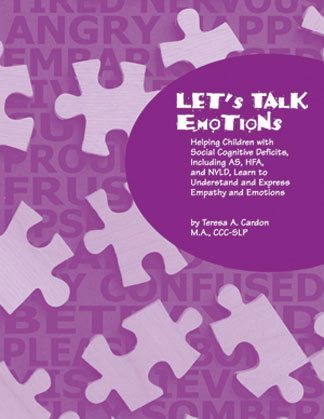
Let’s Talk Emotions: Helping Children with Social Cognitive Deficits, Including AS, HFA, and NVLD, Learn to Understand and Express Empathy and Emotions
The often overlooked area of emotions, which poses a major challenge for children with autism spectrum and other social cognitive challenges, receives major emphasis in this collection of easy-to-use activities for children ages 4-18. Children learn to identify and respond to their own feelings as well as the feelings of others, thereby improving their chances of maintaining and establishing fulfilling and successful social relationships.
Reviewed by Maureen Bennie
Director, of Autism Awareness Centre Inc.
Children with social cognitive deficits (SCD) have difficulty identifying emotions in other people and themselves. Author Teresa Cardon, director of the Speech and Language Department at the Southwest Autism Research and Resource Centre in Phoenix, Arizona, has put together activities to teach emotions and empathy. The activities, aimed at ages 3 – 18, are designed to help those with Asperger Syndrome, high functioning autism, and non-verbal learning disability. Children with these diagnoses do not read non-verbal cues such as facial expressions, body language, tone and voice inflections. Since 90% of communication is non-verbal, it is easy to see why these children do not read other people’s emotions. This deficit results in these children being labeled as rude, at risk for false friendships because they don’t see when they are being taken advantage of, and are thought to have a lack of empathy because they do not interpret the words and actions of others. They also have difficulty understanding their own emotions. Their nonchalant attitude makes them seem outwardly defiant and disrespectful which stems from having missed or misinterpreted the non-verbal cues.
Cardon’s goals and objectives for the activities in this book are broken down into two areas – the external focus (other people) and the internal focus (self). She outlines 4 goals for each of these areas and then describes how these goals will be measured in terms of student demonstration. These activities are intended for use in small groups and can be administered by speech pathologists, educators, psychologists and parents. Cardon suggests starting with concrete activities then moving to more abstract areas such as role-playing. Activities can be adjusted for difficulty and age level allowing for flexibility within a program. Cardon also suggests using Carol Gray’s Social Stories in conjunction with the activities.
Each activity begins with a goal, the suitable age range, materials needed, and how to teach the activity. Worksheets that accompany the activities are included in the appendix, which is a real time saver when they do not have to be created from scratch. Materials are simple, easy to find and inexpensive. You would likely have many of the required materials in your home or classroom. A handy space for notes is provided at the bottom of each activity page.
This program can tie into a social skills program, be used in therapy sessions or at home with siblings, and can be part of the school curriculum. What is great about this book is it applicable from preschool to high school. Because these activities are adaptable to the child’s developmental growth, the lessons can be expanded and modified for the child. Cardon takes the guesswork out of how to teach the difficult concept of emotions and empathy in an easy to understand and administer program.
$34.95
In stock
